The internal structure of NPN bipolar transistor looks like this:

Cut-off
You're quite right about the cut-off mode - in this mode there is no current flow into base and no current flow into collector. However, usually the cut-off mode is defined in terms of base-to-emitter voltage (for example: \$V_{BE}\le0.7V\$ - cut-off).
The reason why there will be no current in cut-off is because the BE junction is reverse biased and does not allow for current to flow through it.
Note that saying that there will be no current flow is an approximation - there will be leakage currents (these low currents are usually neglected).
Active mode
In active mode of operation the BE junction is forward biased (usually stated as \$V_{BE} \ge 0.7V\$), while the CB junction is reverse biased because \$V_{CE}>V_{BE}\$ (\$V_{CB}>0V\$).
In active mode any current flowing into the base terminal will result in an amplified current flowing into the collector terminal (by a factor of \$\beta\$). This mode of operation is useful for amplifiers.
Saturation mode
In saturation mode of operation the BE junction is still forward biased, but CB junction also becomes forward biased (\$V_{CB}<0\$).
You can think of saturation mode as being the limiting case of active mode: if too much biasing current is flowing into the base in active mode, the current flowing into collector becomes very large, thus causing the collector's voltage to go down. Why this happens? Because the circuit supplying current to the collector will usually have some resistance, thus the increased current will lead to an increase in voltage drop on this resistance, leading to a reduction in collector's voltage.
At the onset of saturation mode (which is the the offset of active mode) the current gain is still \$\beta\$, but it reduces the deeper the device in saturation. This means that there is current amplification in "early" saturation (collector's current is still controlled by the base current), but the differential amplification factor reduces to 0 at some point, thus causing the collector's current to become insensitive to base current.
Answer
There usually be some dependence of collector's saturation current on base current, but the ratio will be lower than \$\beta\$ (which is known as the "current gain of the transistor in forward active mode").
